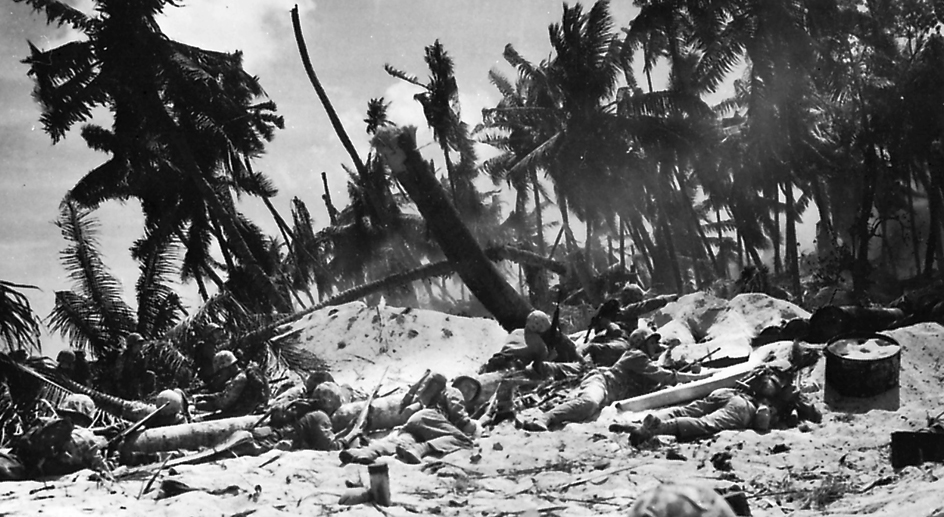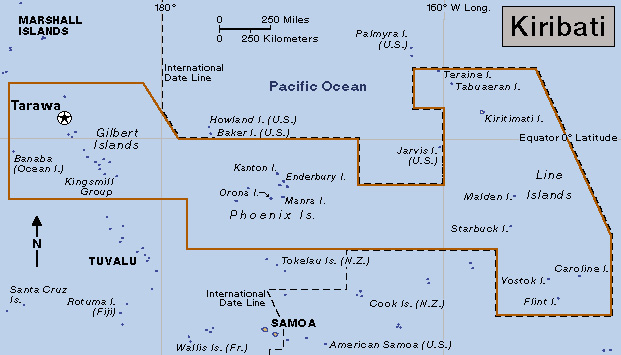Tarawa, Battle of, was a clash between Japanese and United States forces during World War II (1939-1945). The battle took place in November 1943 and ended in a U.S. victory. Tarawa, in the Gilbert Islands, is the modern capital of the Pacific island nation of Kiribati. Tarawa is an atoll (ring-shaped reef) made up of many coral islets that cover about 9 square miles (23 square kilometers). The U.S. attack on Tarawa was the first of several amphibious invasions across the Central Pacific. Such invasions involved naval, air, and land forces. Lessons learned at Tarawa helped U.S. forces improve later seaborne attacks.

Background.
The Japanese military raided Tarawa, a former British possession, in December 1941. They returned to occupy the atoll in September 1942. The Japanese built an airstrip on Tarawa’s largest islet, Betio. To defend the islet, the Japanese built a fortified network of barbed wire, bunkers, minefields, trenches, and tunnels. Nearly all the fighting for Tarawa took place on Betio.

The United States captured Guadalcanal , in the Solomon Islands, in 1942. American military leaders next focused on Tarawa and other islands in the Gilberts. Capture of the Gilberts would clear the Americans’ path to the Marshall and Mariana islands, bringing U.S. forces closer to Japan. The U.S. plan, Operation Galvanic, sent more than 200 ships carrying about 35,000 troops to seize several atolls in the Gilberts. The ships also carried numerous amphibious tractors, called landing vehicles tracked (LVT’s). Planners believed the LVT’s would be able to carry troops over the reefs near Tarawa’s beaches.
A U.S. invasion force of about 18,000 troops attacked Tarawa, the primary target of Operation Galvanic. Nearly 5,000 Japanese troops, nearly all of them on Betio, defended Tarawa.
The battle.
On Nov. 20, 1943, U.S. Marines reached Betio’s northern beaches. In spite of shallow waters from an erratic tide, the first wave of LVT’s made it across the reefs. Following landing craft hung up on the reef, however, forcing Marines to wade several hundreds yards to shore. In the water and on the beaches, they faced fierce enemy fire. Casualties (people killed and wounded) were heavy. Troops who made it to shore clung desperately to a tiny beachhead (foothold). The Japanese defenders fought viciously, and the Marines made slow progress.

Fighting continued on November 21, as the Marines pushed onto Betio’s airfield. Marines also captured a protected landing area to the west. Tide waters rose and troops and equipment began to pour ashore. Facing a succession of concrete bunkers and fortified shelters, the Marines slowly rooted out the Japanese. They also repulsed a number of suicidal charges, called banzai attacks. On November 23, the Marines eliminated the last organized Japanese resistance and secured Betio.
Aftermath.
The four-day fight for Tarawa cost the lives of over 1,000 U.S. Marines and sailors, with more than 2,000 wounded. Of the nearly 5,000 Japanese troops on the island, just 17 combat soldiers chose surrender over death. The capture of Tarawa and nearby Makin atoll (now called Butaritari atoll) brought the Gilbert Islands under U.S. control. Assaults on the Marshall Islands, to the northwest, began in early 1944.
